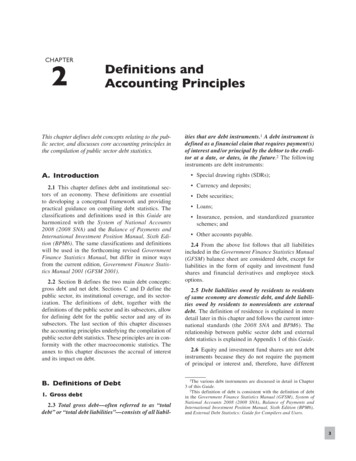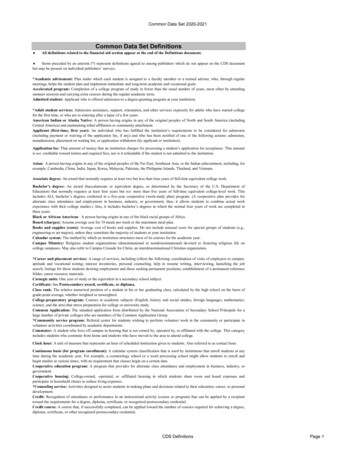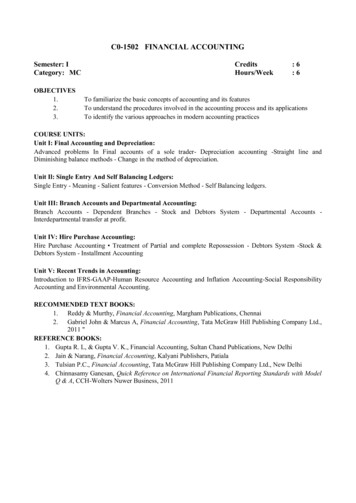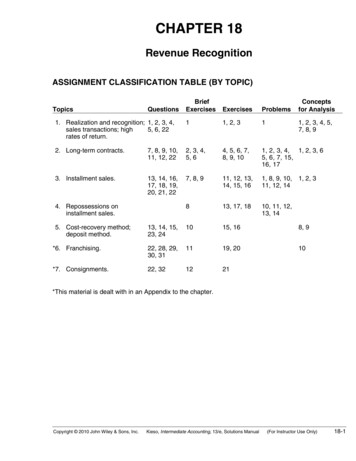
Transcription
CHAPTER2Definitions andAccounting PrinciplesThis chapter defines debt concepts relating to the pub lic sector, and discusses core accounting principles inthe compilation of public sector debt statistics.ities that are debt instruments.1 A debt instrument isdefined as a financial claim that requires payment(s)of interest and/or principal by the debtor to the credi tor at a date, or dates, in the future.2 The followinginstruments are debt instruments:A. Introduction Special drawing rights (SDRs);2.1 This chapter defines debt and institutional sec tors of an economy. These definitions are essentialto developing a conceptual framework and providingpractical guidance on compiling debt statistics. Theclassifications and definitions used in this Guide areharmonized with the System of National Accounts2008 (2008 SNA) and the Balance of Payments andInternational Investment Position Manual, Sixth Edi tion (BPM6). The same classifications and definitionswill be used in the forthcoming revised GovernmentFinance Statistics Manual, but differ in minor waysfrom the current edition, Government Finance Statis tics Manual 2001 (GFSM 2001). Currency and deposits;2.2 Section B defines the two main debt concepts:gross debt and net debt. Sections C and D define thepublic sector, its institutional coverage, and its sector ization. The definitions of debt, together with thede finitions of the public sector and its subsectors, allowfor defining debt for the public sector and any of itssubsectors. The last section of this chapter discussesthe accounting principles underlying the compilation ofpublic sector debt statistics. These principles are in con formity with the other macroeconomic statistics. Theannex to this chapter discusses the accrual of in terestand its impact on debt.B. Definitions of Debt1. Gross debt2.3 Total gross debt—often referred to as “totaldebt” or “total debt liabilities”—consists of all liabil Debt securities; Loans; Insurance, pension, and standardized guaranteeschemes; and Other accounts payable.2.4 From the above list follows that all liabilitiesincluded in the Government Finance Statistics Manual(GFSM) balance sheet are considered debt, except forliabilities in the form of equity and investment fundshares and financial derivatives and employee stockoptions.2.5 Debt liabilities owed by residents to residentsof same economy are domestic debt, and debt liabili ties owed by residents to nonresidents are externaldebt. The definition of residence is explained in moredetail later in this chapter and follows the current inter national standards (the 2008 SNA and BPM6). Therelationship between public sector debt and exter naldebt statistics is explained in Appendix 1 of this Guide.2.6 Equity and investment fund shares are not debtinstruments because they do not require the pay mentof principal or interest and, therefore, have dif ferent1The various debt instruments are discussed in detail in Chapter3 of this Guide.2This definition of debt is consistent with the definition of debtin the Government Finance Statistics Manual (GFSM), System ofNational Accounts 2008 (2008 SNA), Balance of Payments andInternational Investment Position Manual, Sixth Edition (BPM6),and External Debt Statistics: Guide for Compilers and Users.3
PUBLIC SECTOR DEBT STATISTICS: GUIDE FOR COMPILERS AND USERSimplications for vulnerability and liquidity. For thesame reason, financial derivatives—both forwards andoptions—are not debt liabilities because no princi palis advanced that is required to be repaid, and no inter est accrues on any financial derivative instru ment.3In Chapter 5, this Guide recommends to compile anddisseminate data on financial derivatives positions asa memorandum to public sector debt statistics. Suchinformation is useful because these contracts can addto a public sector unit’s liabilities and, if used inappro priately, cause significant losses.42.7 Due to specific legal, institutional, and practi calarrangements, some definitions of debt other than theabove may also exist. It is therefore useful to alwaysclearly identify the definition of debt accor ding tothe instruments included. Total debt in this Guidecovers all debt instruments specified in para graph 2.3,but narrower definitions are sometimes presented,including: only currency and deposits, debt securities, andloans—a narrow definition confined to instru ments traditionally used to “raise funds”; and all debt instruments except insurance, pension,and standardized guarantee schemes—a broaderdefini t ion close to total debt that primarilyexcludes pension liabilities.a. Outstanding and actual current liabilities2.8 For a liability to be considered debt it mustexist and be outstanding.5 The decisive consideration iswhether a creditor has a claim on the debtor. Debt lia bilities are typically established through the pro visionof economic value by one institutional unit, the credi tor, to another, the debtor, normally under a con tractualarrangement. Debt liabilities can also be created by theforce of law,6 and by events that require future transferpayments.7 Debt liabilities include ar rears of principaland interest. Commitments to pro vide economic valuein the future do not establish debt liabilities until itemschange ownership, services are rendered, or income3Off-market swaps do have a debt component, as outlined inChapter 4.4See Chapter 5, paragraphs 5.50–5.52.5See Chapter 3, paragraphs 3.5–3.12 for a more detailed discus sion of liabilities and financial assets.6These liabilities could include those arising from taxes, penal t ies(including penalties arising from commercial contracts), and judicialawards at the time they are imposed.7These include claims on nonlife insurance companies, claimsfor damages not involving nonlife insurance companies, and claimsarising from lottery and gambling activity.4accrues; for example, amounts yet to be disbursedunder a loan or export credit com mitment are not to beincluded in the gross debt position.2.9 Contingencies are conditions that may affect thefinancial performance of public sector units, dependingon the occurrence, or nonoccurrence, of one or morefuture events. Contingencies, such as the granting ofmost one-off guarantees,8 are not in cluded in the debtof the guarantor because they are not unconditionalliabilities. Guaranteed debt continu es to be attributed tothe debtor, not the guarantor, un less and until the guar antee is called. However, for purposes of vulnerabilityanalysis, the potential impact of contingent liabilitieson public sector units matters. Therefore, while con tingencies are excluded from the definition of debt ofthe guarantor, the value of speci fic contingent liabili ties may be shown as a memo randum item in publicsector debt statistics. This Guide encourages countriesto set up systems to moni tor and disseminate data oncontingent liabilities, as is discussed in more detail inChapter 4.9b. Principal and interest2.10 The provision of economic value by the credi tor, or the creation of debt liabilities through othermeans, establishes a principal liability for the debtor,which, until extinguished, may change in value overtime. Interest is the cost (expense) that the debtor incursfor the use of the principal outstanding.10 Thus, interestis a form of investment income that is receivable bythe owners of certain kinds of financial assets (SDRs,deposits, debt securities, loans, and other accountsreceivable) for putting these financial and otherresources at the disposal of another insti tutionalunit. For most purposes, interest is an accrual concept.However, from a cash accounting perspec tive, periodicdebt-service payments can be classified as interestpayments11 or principal payments. The accrual ofinterest is described in the annex to this chapter.8One-off guarantees occur where the risk of a loan or securityguaranteed cannot be calculated with any degree of accuracy. Inmost cases, these instruments are not recognized as financial assetsor liabilities until called, and are not recorded in the 2008 SNA orGFSM.9Standardized guarantees, which give rise to actual and not con tingent liabilities, are discussed in Chapter 3.10In other words, interest is the amount debtors will have topay their creditors over and above the repayment of the amountsadvanced by the creditors.11For long-term debt instruments, interest paid periodically arethose to be paid by the debtor to the creditor annually or more fre quently; for short-term instruments (i.e., with an original maturity ofone year or less), interest paid periodically are those to be paid by
Chapter 22.11 The definition of debt does not differenti ate between principal and interest accrued. That is,the amount outstanding debt is a total that includesre sources originally advanced plus interest accrued todate minus any repayments. It is the future require mentto make payments, not the form of those pay ments, thatdetermines whether a liability is a debt in strument ornot. Payments could be made in any form, for example,currency and deposits, or goods and ser vices.2.12 The definition of debt does not necessarily implythat the timing of future payments of principal and/orinterest is known. In many instances, the schedule ofpayments is known, such as on debt secu rities and loans.However, in other instances the exact schedule of pay ments may not be known. For exam ple, the timing ofpayment might be at the demand of the creditor, suchas for noninterest-bearing demand deposits; or whenthe debtor is in arrears, and it is not known whether orwhen the arrears will actually be paid. Once again, it isthe requirement to make the payment that determineswhether the liability con stitutes debt, rather than the tim ing of the payments. The liabilities of pension fundsand life insurance companies to their participants andpolicyholders are considered as debt of those institutionsbecause at some point in time a payment is due, eventhough the timing of that payment may be unknown.2. Net debt2.13 For risk management, debt liabilities and assetsmay be dealt with in an integrated manner, focusing onnet debt. For example, debt may have been incurredto fund assets that will generate income to meet lia bilities. Net debt is calculated as gross debt minusfinancial assets corresponding to debt in struments,as illustrated in Table 2.1. Net worth and the balancesheet, which cover an even wider range of assets andliabilities, are discussed in more detail in Chapter 3,Section B.2.14 Monetary gold, as defined in 2008 SNAand BPM6, includes elements of a debt instrument(un allocated gold accounts) and a nondebt instrument(gold bullion). In principle, the gold bullion element ofmonetary gold should be excluded from the cal culationof net debt. However, in practice, the total amount formonetary gold may have to be used in the net debt cal culation because compilers of public sector debt statis tics may not be able to exclude the gold bullion element.the debtor to the creditor before the redemption date of the instru ment. Interest payments are distinct from the concept of accruinginterest over the life of the liability. Definitions and Accounting PrinciplesTable 2.1. Calculation of Net DebtGross debt(liabilities in theform of debtinstruments)(a)SDRsFinancial assetscorresponding todebt instrumentsNet debt(b)(c) (a)–(b)Currency anddepositsMonetary goldand SDRsCurrency anddepositsDebt securitiesLoansInsurance, pension,and standardizedguaranteeschemesOther accountspayableDebt securitiesLoansInsurance, pension,and standardizedguaranteeschemesOther accountsreceivableTotal gross debtTotal financial assetscorresponding togross debtTotal netdebtC. Institutional Units and Sectors2.15 An economy can be divided into sectors, witheach sector consisting of a number of institutionalunits12 that are resident in the economy (see Box 2.1).This Guide follows the 2008 SNA by dividing an eco nomy into five mutually exclusive institutional sec tors.The units in each sector have similar economic objec tives that can be differentiated from those of other sec tors. The five institutional sectors are: The nonfinancial corporations sector, whichconsists of resident institutional units that are prin cipally engaged in the production of market goodsor nonfinancial services; The financial corporations sector, which consistsof resident institutional units that are principallyengaged in providing financial services, includingfinancial intermediation, to other institutional units; The general government sector, which consistsof resident institutional units that fulfill the func tions of government as their primary activity. Inother words, those institutional units that produceservices (and possibly goods) for individual or col lective consumption, primarily on a nonmarketbasis, and redistribute income and wealth, in addi tion to fulfilling their political responsibilities andtheir role of economic regulation; The households sector, which consists of a groupof persons who share the same living accommo 12 Hereafter, “unit” will often be used as a short form for“in stitutional unit.”5
PUBLIC SECTOR DEBT STATISTICS: GUIDE FOR COMPILERS AND USERSBox 2.1. Definition of an Institutional UnitAn institutional unit is an economic entity that iscapable, in its own right, of owning assets, incurringliabilities, and engaging in economic activities and intransactions with other entities. Some important fea tures of institutional units follow: The ability of an institutional unit to own goods orassets in its own right means that it is also able toexchange the ownership of goods or assets in trans actions with other institutional units. An institutional unit is able to take economic deci sions and engage in economic activities for which it isitself held directly responsible and accountable at law. An institutional unit is able to incur liabilities on itsown behalf, to take on other obligations or futurecommitments, and to enter into contracts. Either a complete set of accounts, including a bal ance sheet of assets, liabilities, and net worth, existsfor an institutional unit, or it would be possible andmeaningful, from both an economic and legal view point, to compile a complete set of accounts if theywere required.There are two main types of entities that may qualify asinstitutional units: (1) persons or groups of persons in theform of households and (2) legal or social entities, whoseexistence is recognized by law or society independently ofthe persons or other entities that may own or control them.The four types of legal or social entities recognized in the2008 SNA and this Guide as institutional units are cor porations, quasi-corporations, nonprofit institutions, andgovernment units. The status of institutional units cannotalways be inferred from its name, and it is necessary toexamine its objectives and functions.dation, who pool some, or all, of their income andwealth and who consume certain types of goodsand services collectively (mainly housing andfood). Households may be of any size and takea variety of different forms in different societiesor cultures. All physical persons in the economymust belong to one and only one household. Theprinci pal functions of households are to supplylabor, to undertake final consumption, and, asentrepreneurs, to produce market goods and non financial (and possibly financial) services; and The nonprofit institutions serving households(NPISHs) sector, which consists of resi dent non market nonprofit institutions (NPIs) that are notcontrolled by government.13 They provide goods13NPIs are legal or social entities, created for the purpose of pro ducing goods and services, whose status does not permit them to besource of income, profit, or other financial gain for the units that6and services to households free or at prices thatare not economically significant.2.16 Each of these sectors may be divided into sub sectors, and the subsectors can be combined in differ entways to form other sectors. For example, the gene ralgovernment sector can be divided into central, state, andlocal government subsectors, and the non financial cor porations sector can be divided into pub lic nonfinancialcorporations, foreign-controlled non financial corpora tions, and national private nonfinan cial corporations.142.17 The public sector consists of all residentinstitutional units controlled directly, or indirectly,by resident government units, that is, all units of thegeneral government sector, and resident public cor porations (see Figure 2.1).15 Control is defined as theability to determine general corporate policy of thecorporation. “General corporate policy” refers to, ina broad sense, the key financial and operating poli cies relating to the corporation’s strategic object ivesas a market producer. The 2008 SNA lists eight indi cators that should assist in determining whether a cor poration is controlled by a government unit or anotherpublic corporation16: (1) ownership of the majority ofthe voting interest; (2) control of the board or othergoverning body; (3) control of the ap pointment andremoval of key personnel; (4) control of key committeesof the entity; (5) golden shares and options; (6) regu lation and control; (7) control by a dominant publicsector customer or group of public sector customers;and (8) control attached to borrow ing from the govern ment. Although a single indicator could be sufficient toestablish control, in other cases, a number of separateindicators may collectively indi cate control.2.18 The general government sector comprises allgovernment units and all nonmarket nonprofit insti tutions (NPIs) that are controlled by government units:establish, control, or finance them. Nevertheless, some NPIs delivergoods and services to customers at economi cally significant pricesand, when they do, these NPIs are treat ed in the same way as corpora tions in the 2008 SNA. Other NPIs that are controlled by governmentand are engaged in nonmarket production are treated as governmentunits. The remaining NPIs, those that produce goods and servicesbut do not sell them at economically significant prices and are notcontrolled by government, are treated as a special group of units calledNPIs serving households, or as part of corporations, if they serve them.14 Similarly, financial corporations can be divided into public,foreign-controlled, and national private financial corporations,respectively.15For a complete discussion on the sectorization of the publicsector, see GFSM 2001 Companion Material, Coverage and Sector ization of the Public Sector, by Paul Cotterell, Ethan Weisman, andTobias Wickens, December 2006, IMF, Washington, DC. mp.htm)16See 2008 SNA, paragraphs 4.77–4.80 for more details.
Chapter 2 Definitions and Accounting PrinciplesFigure 2.1. The Public Sector and Its Relation to Other Institutional Sectors of the ublicPrivate Government units are institutional units with legis lative, judicial, or executive authority over otherinstitutional units within a given area; they assumeresponsibility for the provision of goods and ser vices to the community or to individual householdson a nonmarket basis; they make transfer paymentsto redistribute income and wealth; and they financetheir activities mainly by means of taxes and otherincome from units in other sectors of the economy. Nonmarket NPIs that are controlled by govern ment units are legal or social entities created for thepurpose of producing goods and services on a non market basis, but whose status does not permit themto be a source of income, profit, or other fi nancialgain for government. Even though NPIs may havea legal status of nongovernment entities, they areconsidered to be carrying out government policiesand, thus, effectively are part of govern ment. The2008 SNA lists five indicators that should assistin determining whether an NPI is controlled by agovernment unit: (1) the appoint ment of officers;(2) other provisions of the en abling instrument;(3) contractual agreements; (4) degree of financingby government; and (5) risk exposure.2.19 Public corporations include all corporationscontrolled by government units or by other publiccorporations. Corporations subject to the control ofa government (or public corporation) that is resi dent in a different economy from that governmentare not classified as public corporations.17 Corpora tions are all entities that are (i) capable of generat ing a profit or other financial gain for their owners,(ii) recog nized by law as legal entities separate from17Alsosee the discussion of residence later in this ngHouseholdsSectorPrivatePrivatePrivatetheir owners who enjoy limited liability, and (iii) set upfor purposes of engaging in market production (i.e., pro ducing goods and services at economically signi ficantprices18). Quasi-corporations, which are not in corporatedor otherwise legally established, but func tion as if theywere corporations, are also classified as corporations.Market NPIs (i.e., NPIs engaging in market production)are also classified as corporations. Corporations are partof the nonfinancial corporations sector or financial cor porations sector in the economy, depending on the natureof their primary activity. Institutional units controlled bygovernment, that are legally established as corporationsbut are not market producers (i.e., they do not sell theiroutput at eco nomically significant prices), are classifiedas part of the general government sector, not the publiccorpora tions sector. Similarly, unincorporated enterprisesowned by government units that are not quasi-corpo rations remain integral parts of those units and, there fore,must be included in the general government sector.D. Institutional Coverage andSectorization of the Public Sector2.20 The public sector is a combination of the generalgovernment sector and all public corporations. Figure2.2 illustrates the public sector and its main components.1. The general government sector and itssubsectors2.21 For analytic purposes, it is often necessary ordesirable to disaggregate the statistics of the generalgovernment sector. Two primary methods of construc 18 Economically significant prices are prices that have a sig nificant influence on the amounts that producers are willing tosupply and on the amounts that purchasers wish to buy.7
PUBLIC SECTOR DEBT STATISTICS: GUIDE FOR COMPILERS AND USERSFigure 2.2. The Public Sector and Its Main ComponentsPublic SectorGeneral GovernmentCentral GovernmentPublic nancialCorporationsState GovernmentCentral BankLocal GovernmentPublic Deposit-TakingCorporations Except theCentral BankOther Public FinancialCorporationsting subsectors are presented; the difference betweenthem is the result of alternative treatments of socialsecurity funds.funds and their role in fiscal policy may require thatstatistics for all social security funds be compiled asa separate subsector of the general government sector.2.22 Depending on the administrative and legalarrangements, there may be more than one level ofgovernment within a country, and statistics should becompiled for each level (also referred to as a sub sector).However, because of these different arrange ments, dataat each subsector of government are not suitable forinternational comparisons. Only general governmentand public sector data are internationally comparable.2.24 The requirements to classify general govern ment units according to their level of government, andwhether they are a social security fund (see paragraphs2.44–2.46), can be accommodated in two alternative setsof subsectors, as outlined in the GFSM and 2008 SNA.192.23 In the GFSM and 2008 SNA, provision is madefor three subsectors of general government: central;state, provincial, or regional; and local. Not all coun tries have all three levels; some may have only a cen tral government or a central government and one levelbelow. Other countries may have more than three levels.In that case, the various units should all be classified asone of the three subsectors suggested here. In additionto levels of government, the exis tence of social security8 All social security funds could be combined into aseparate subsector and all other general govern mentunits could be classified according to their level. Inthat case, the central, state, and local gov ernmentsubsectors would comprise all govern ment unitsother than social security funds (Figure 2.3); or19 The alternative methods of subsectoring are designed toac commodate different analytic needs. The decision as to whichmethod is more appropriate in a given country depends on howsignificant social security funds are and on the extent to which theyare managed independently of the government units with which theyare associated.
Chapter 2Figure 2.3. The General GovernmentSector and Its Main SubsectorsCentral GovernmentSubsector 1General Government SectorState Government Subsector 1Local Government Subsector 1Social Security FundsSubsector21Includes social security funds.2Alternatively, social security funds can be combined into a separate sector, asshown in the box with dashed lines. Social security funds could be classified accord ing to the level of government that organizes andman ages them and combined with the other gen eral government units at that level. Thus, the gen eral government would consist of central, state,and local government, assuming that all three lev els of government exist (Figure 2.3). To facilitateanalysis of social security funds as a whole, sepa rate statistics for them may be provided within thestatistics for each level of government.Countries may choose either presentation. For pur poses of consistency and comparability, the GFS Year book adopts a single approach.a. Budgetary and extrabudgetary2.25 The central, state, and local government sub sectors of general government are each made up of insti tutional units (see paragraph 2.23). For each of thesesubsectors, it is often analytically useful to group itsentities according to administrative arrangements anddistinguish between a budgetary component and thosethat are extrabudgetary (irrespective of the treatment ofsocial security funds—see paragraph 2.24). The budget ary component may only comprise the main (or general)budget and the extrabudgetary component of the remain ing entities that constitute that level of government,excluding social security funds. Such a grouping allowsfor a more direct comparison of the budget data with thestatistics. Whether entities are classified as budgetary Definitions and Accounting Principlesor extrabudgetary depends on country circumstances.What is important, though, is that the statistics for eachlevel of government cover all entities that constitute thatsubsector of government (central, state, or local), basedon macroeconomic sta tistical guidelines.2.26 In all countries, there is an institutional unitof the general government sector important in termsof size and power, in particular the power to exercisecontrol over many other units and entities. The budge tary central government is a single unit of the centralgovernment that encompasses the fundamental activ ities of the national executive, legislative, and judici ary powers. This component of general government isusually covered by the main (or general) budget. Thebudgetary central government’s revenues, as well asits expenses and outlays, are normally regulated andcontrolled by a Ministry of Finance, or its functionalequivalent, by means of a general budget approved bythe legislature. Most of the ministries, departments,agencies, boards, commissions, judicial authorities,legislative bodies, and other entities that make up thebudgetary central government are not separate institu tional units. This is because they generally do not havethe authority to own assets, incur liabilities, or engagein transactions in their own right. The state or localgovernment subsectors also have each a budgetarystate/local government component that includes theprincipal executive, legislative, and judicial powers forthese levels of government. They may also have extra budgetary components.2.27 General government entities with individualbudgets not fully covered by the general budget areconsidered extrabudgetary.20 These entities operateunder the authority or control of a central, state, or localgovernment. Typically, extrabudgetary entities havetheir own revenue sources, which may be supple mentedby grants (transfers) from the general budget or fromother sources, and have discretion over the volume andcomposition of their spending. Such en tities are oftenestablished to carry out specific func tions, such as roadconstruction or the nonmarket production of healthor education services. Budgetary arrangements varywidely across countries, and vari ous terms are used todescribe these entities, but they are often referred toas “extrabudgetary funds” or “de centralized agencies.”20These government entities are institutional units if they main tain full sets of accounts, own goods or assets in their own right,engage in nonmarket activities for which they are held accountableat law, and are able to incur liabilities and enter into contracts in theirown right. If an entity does not qualify as a unit, it is considered aspart of the unit that controls it.9
PUBLIC SECTOR DEBT STATISTICS: GUIDE FOR COMPILERS AND USERS2.28 Nonmarket NPIs controlled by governmentare typically classified as extrabudgetary units becausethey generally have the authority to own assets, incurliabilities, or engage in transactions in their own right.More specifically, they are classified with the level ofgovernment that controls them, i.e., central, state, orlocal government. Indicator
Accounting Principles This chapter defines debt concepts relating to the pub lic sector, and discusses core accounting principles in the compilation of public sector debt statistics. A. Introduction 2.1 This chapter defines debt and institutional











